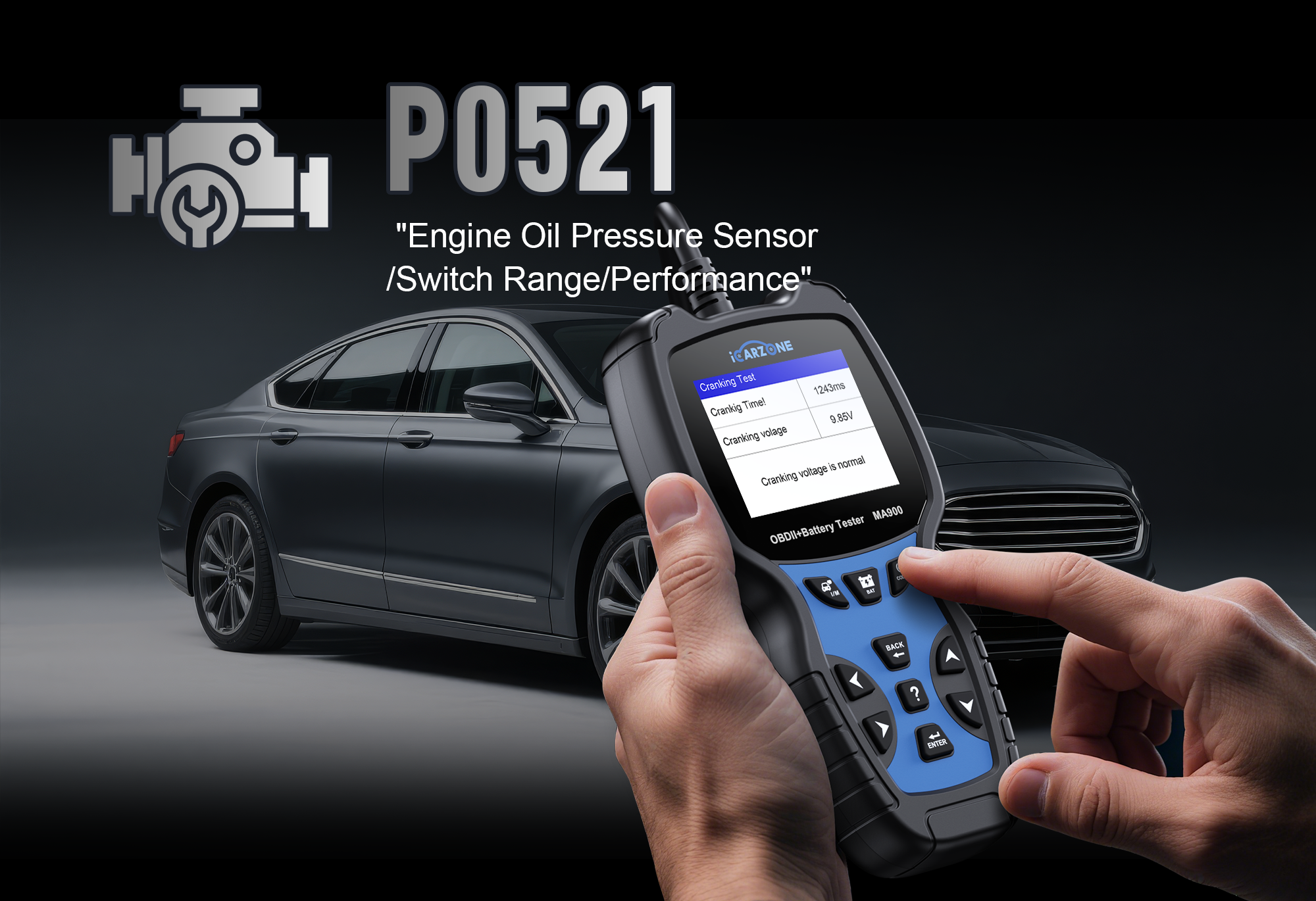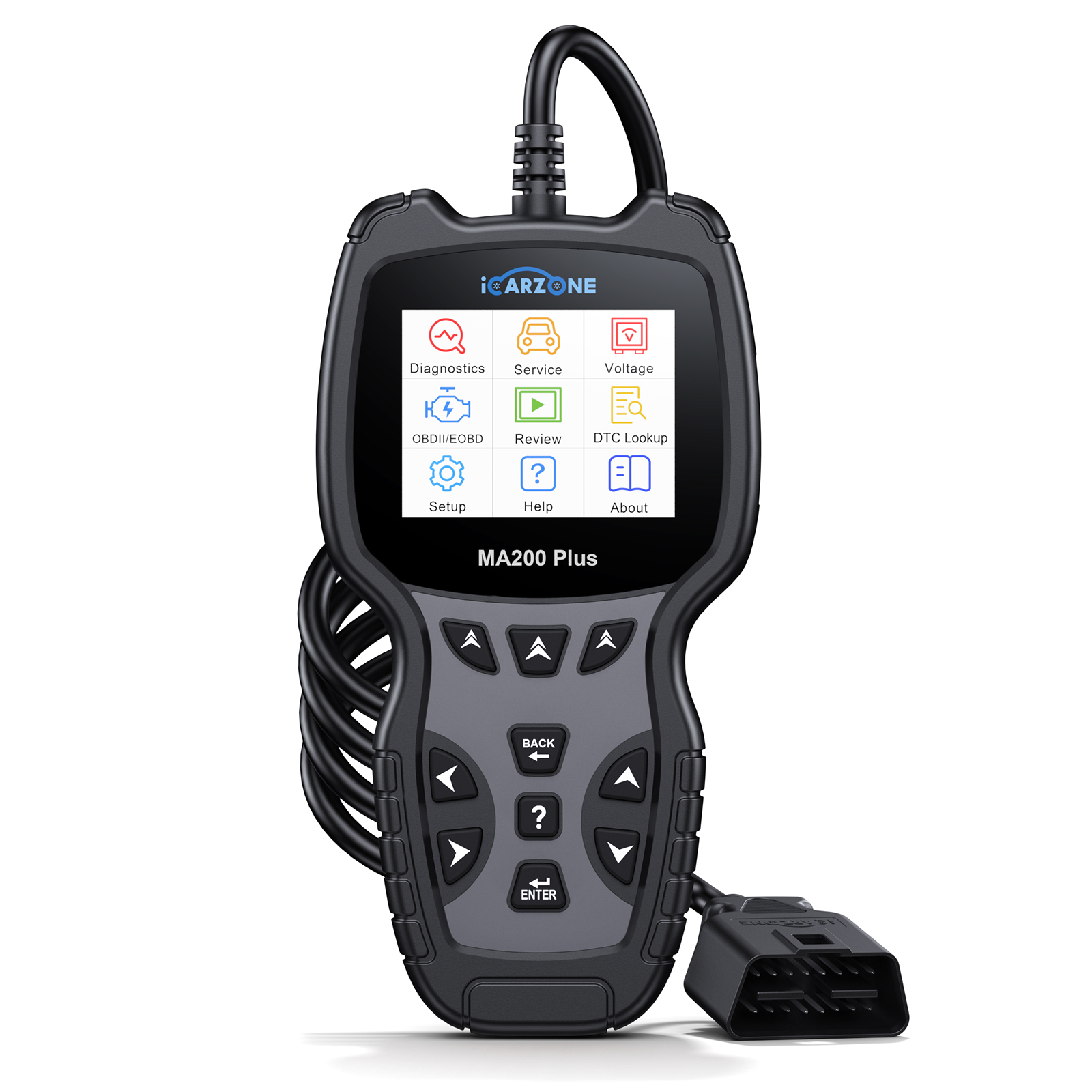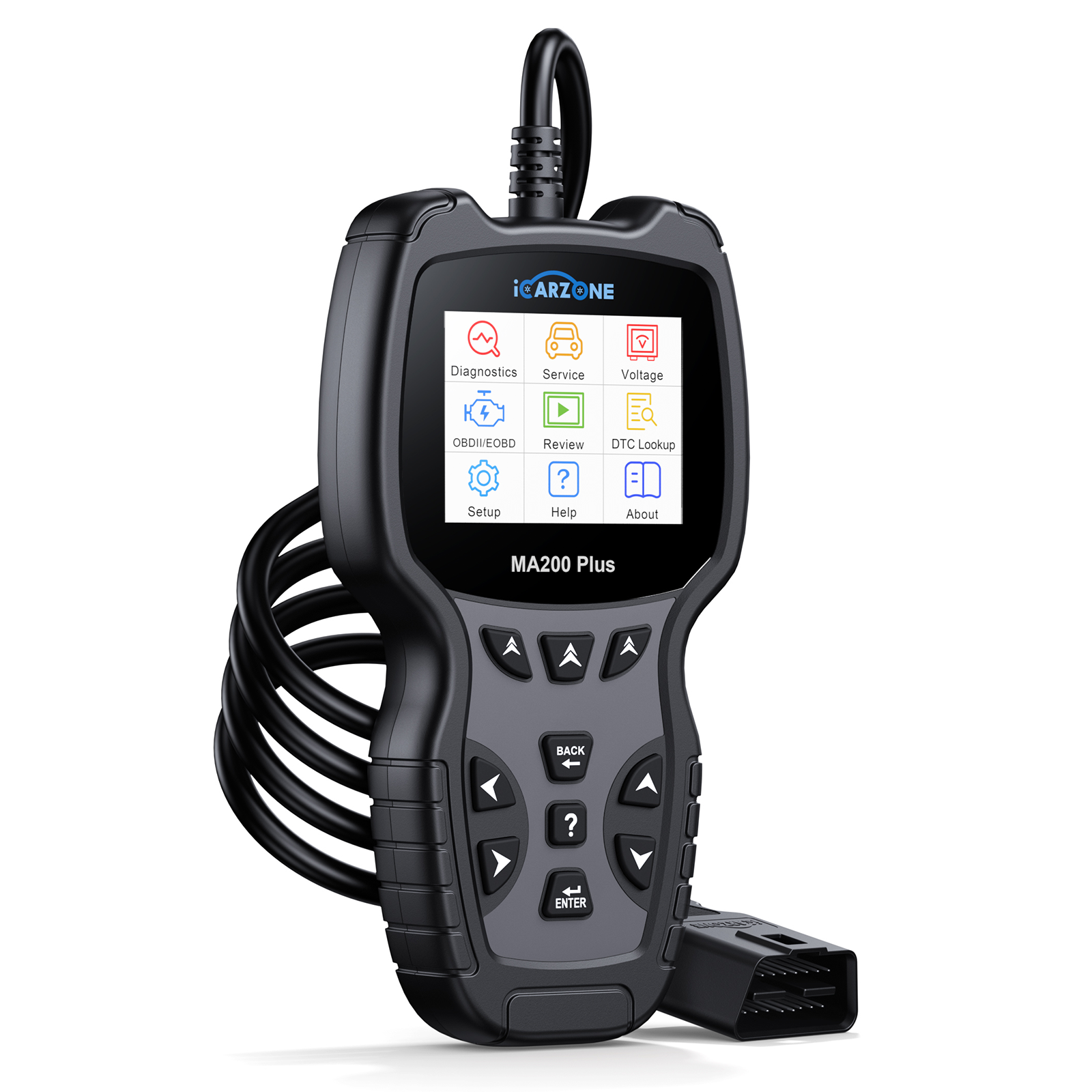P0521 Code in Volkswagen Golf: 2025 DIY Fix with ICARZONE MA900

P0521 Code in Volkswagen Golf: Fix with ICARZONE MA900
Solve oil pressure sensor issues in 2015-2024 Golf models. Diagnose and repair performance problems with MA900's VW-specific tools.
Fix P0521 with MA900 Now1. What is P0521 in Volkswagen Golf?
P0521 is an OBD-II Diagnostic Trouble Code indicating an Oil Pressure Sensor/Switch Range/Performance Problem. In the Volkswagen Golf—one of the most popular compact hatchbacks worldwide—this code signals an issue with the oil pressure monitoring system that protects the engine from damage.
The Golf's oil pressure sensor, strategically located near the oil filter housing, continuously monitors oil pressure and sends this data to the Engine Control Unit (ECU). This is particularly critical in performance-oriented models like the GTI and R, where proper oil pressure is essential during high-performance driving. P0521 specifically indicates that the signal from the sensor is outside the expected range under normal operating conditions.

Why P0521 Matters for Golf Owners
Volkswagen engineered the Golf's oil system for both efficiency and performance. An oil pressure sensor issue creates several critical problems:
- Illuminated Check Engine Light and often the oil pressure warning light
- Risk of engine damage due to undetected low oil pressure
- Potential for reduced engine performance as ECU enters protection mode
- GTI and R models may experience turbocharger damage without proper oil pressure
- 2019+ Golf models may enter "Limp Mode" to protect engine components
- Inaccurate oil pressure readings during cold starts and high RPM operation
2. Common Causes in 2015-2024 Volkswagen Golf
Failing Oil Pressure Sensor (2018 Golf GTI SE) — A 2018 GTI owner with 58,000 miles noticed the oil pressure warning light flickering during acceleration. ICARZONE MA900's Oil Pressure Sensor Test showed erratic voltage readings. The sensor had degraded due to the high operating temperatures of the 2.0T engine. Replacing with OEM sensor #06K919081 resolved the unstable readings.Wiring Harness Damage (2019 Golf R) — A 2019 Golf R owner's P0521 appeared after engine bay cleaning. MA900's Circuit Continuity Test identified a damaged wire. Inspection revealed the sensor's wiring harness had been nicked by the alternator bracket during previous service—a common issue in the tightly packed engine bay of the Golf R.Oil Pressure Switch Connector Issues (2020 Golf S 1.4T) — A 2020 Golf S owner experienced intermittent P0521. MA900's Connection Resistance Test showed high resistance at the sensor connector. The plastic retainer had worn, creating an intermittent connection. Replacing the connector pigtail (#8K0972702) with improved VW revision fixed the issue.Engine Oil Issues (2017 Golf GTI Autobahn) — A 2017 GTI owner using non-specified oil developed P0521. MA900's Oil Pressure Monitoring showed proper mechanical pressure but sensor misreading. The 5W-30 oil used didn't meet VW 502.00 specification, causing sensor lubrication issues. Switching to VW-spec 5W-40 synthetic oil resolved the code.ECU Software Calibration (2021 Golf GTI Mk8) — A 2021 Mk8 GTI owner experienced P0521 during cold starts. MA900's VW TSB Lookup identified TSB 21-03-05, which addressed overly sensitive sensor parameters in early Mk8 models. Updating the ECU software to the latest calibration eliminated the false code.

3. Key Symptoms in Volkswagen Golf Hatchbacks
Warning Indicators
- Illuminated Check Engine Light with P0521 stored
- Oil pressure warning light flickering or staying on
- "Oil Pressure Too Low" message on instrument cluster
- Reduced power mode or "Limp Mode" activation
- Digital dash showing fluctuating oil pressure readings
- Service interval reminder appearing prematurely
Performance Symptoms
- Engine hesitation during acceleration
- Reduced power, especially in GTI/R models
- Turbocharger lag increase in 2.0T engines
- Symptoms worsening when engine is cold
- Issues appearing during high RPM operation
- Intermittent symptoms that vary with engine temperature
4. Golf Engines/Trims Prone to P0521
Volkswagen service data highlights these Golf configurations with highest P0521 incidence:
| Engine | Model Years | Golf Trims | % of P0521 Cases | Primary Risk Factor |
|---|---|---|---|---|
| 2.0T EA888 Gen 3 (220-315hp) | 2015–2024 | GTI, GTI TCR, R | 42% | High operating temperatures affecting sensor longevity |
| 1.8T EA888 Gen 3 (170hp) | 2015–2020 | S, SE, SEL | 23% | Wiring harness proximity to hot engine components |
| 1.4T EA211 (147hp) | 2019–2024 | S, SE, SEL | 18% | Connector issues in early production models |
| 2.0L TDI (147-184hp) | 2015–2019 | TDI S, TDI SE | 11% | Oil contamination affecting sensor operation |
| 1.5T EA211 (158hp) | 2022–2024 | S, SE, SEL | 6% | Software calibration issues in new engine variant |
Critical TSBs for Golf P0521:
- VW TSB 20-12-02 (2015–2019 Golf GTI/R): Oil pressure sensor replacement guidelines for erratic readings.
- VW TSB 21-03-05 (2020–2021 Mk8 Golf): ECU software update to resolve false P0521 codes.
- VW TSB 22-01-12 (2019–2022 Golf 1.4T): Improved wiring harness for oil pressure sensor.
5. Diagnostic Steps with ICARZONE MA900
Diagnosing P0521 in your Golf is precise with ICARZONE MA900's VW-specific engine tools:
| Step | Action with MA900 | Golf-Specific Goal | Pass/Fail Criteria |
|---|---|---|---|
| 1 | Full System Scan > Select "Volkswagen" > "Golf" > "Engine Control Module" | Confirm P0521 and check for related codes (P0520, P0522, P0523, P0524) | Pass: Isolated P0521 | Fail: Multiple oil pressure codes (system-wide issue) |
| 2 | Engine Tests > "Oil Pressure Sensor Test" | Monitor live voltage readings from sensor at various engine loads | Pass: Voltage ranges 0.5-4.5V corresponding to pressure | Fail: Voltage outside expected range |
| 3 | Electrical Tests > "Circuit Resistance Test" |
|
Pass: Resistance 500-1500 ohms | Fail: Open circuit or short to ground |
| 4 | Live Data > "Oil Pressure Monitoring" | Compare sensor data with actual mechanical oil pressure (if equipped) | Pass: Readings correlate | Fail: Sensor readings don't match actual pressure |
| 5 | Service Functions > "VW TSB Lookup" > Enter Golf's VIN | Check for applicable technical service bulletins | Pass: No relevant TSB | Fail: TSB applies (follow recommended fix) |
Case Example: A 2018 Golf GTI with 65,000 miles failed Step 2 (voltage spiked to 5.2V under load) and Step 3 (normal resistance). MA900's VW Component Location feature pinpointed the sensor location near the oil filter housing. Inspection revealed oil leakage around the sensor—common in high-mileage 2.0T engines. Replacing the sensor with OEM part #06K919081 and updating the ECU software using MA900's VW Software Update function resolved P0521. A 100-mile test with various driving conditions confirmed the fix held during both normal and spirited driving.

6. Fixes for Golf's P0521
Resolving P0521 in your Golf requires oil pressure sensor system repairs—here's how to address each root cause with ICARZONE MA900 guidance:
1. Replace Oil Pressure Sensor
- Verify sensor failure using MA900's Oil Pressure Sensor Test.
- Ensure engine is cool and park on level surface.
- Disconnect negative battery terminal.
- Locate sensor based on your Golf model:
- 2015-2024 2.0T GTI/R: Near oil filter housing, front of engine
- 2015-2020 1.8T: Above oil pan, driver's side
- 2019-2024 1.4T: Rear of cylinder head
- 2015-2019 TDI: Front of engine, near timing cover
- Place drain pan under sensor area to catch minor oil spillage.
- Disconnect electrical connector by pressing tab and pulling gently.
- Remove sensor using appropriate socket (typically 24mm or 1-1/16").
- Clean mounting surface and inspect for oil passage blockages.
- Install new OEM sensor with proper torque:
- 2015-2024 2.0T: #06K919081, torque to 25 Nm
- 2015-2020 1.8T: #06J919081A, torque to 22 Nm
- 2019-2024 1.4T: #04E919081, torque to 20 Nm
- 2015-2019 TDI: #04L919081, torque to 25 Nm
- Reconnect electrical connector until it clicks securely.
- Reconnect battery and use MA900 to clear codes and perform Sensor Adaptation.
- Start engine and check for leaks, then verify operation with MA900.
2. Repair or Replace Wiring Harness
- Based on MA900's circuit test results, locate damaged section of harness.
- Common damage points in Golf models:
- 2.0T GTI/R: Harness near turbocharger heat shield
- 1.8T: Wiring rubbing against alternator bracket
- 1.4T: Connector at sensor prone to water intrusion
- All models: Areas near exhaust manifold heat
- For minor damage:
- Disconnect battery before electrical repairs
- Cut out damaged section with wire cutters
- Splice in new 18-gauge heat-resistant wire
- Use heat-shrink butt connectors rated for 125°C+
- Cover repair with heat-resistant loom
- For significant damage or TSB-related issues:
- Replace with TSB 22-01-12 updated harness:
- 2.0T: #06K971614F
- 1.8T: #06J971614G
- 1.4T: #04E971614B
- Follow TSB routing instructions to avoid heat sources
- Use provided heat shields and mounting clips
- Replace with TSB 22-01-12 updated harness:
- After repair, verify with MA900's Circuit Resistance Test.
3. Repair Electrical Connections
- Disconnect battery before working on electrical connections.
- Locate oil pressure sensor connector (varies by engine, see above).
- Remove connector by pressing release tab and pulling straight back.
- Inspect both connector halves for:
- Pin corrosion (common in northern climates with road salt)
- Damaged plastic housing or locking tab
- Pin retracts or bends
- Water intrusion or oil contamination
- Clean corrosion with electrical contact cleaner and small wire brush.
- Straighten any bent pins carefully with small pick tool.
- For damaged connectors:
- Replace with VW pigtail #8K0972702
- Solder connections using heat-shrink insulation
- Seal repair with dielectric grease
- Apply dielectric grease to all pins before reconnecting.
- Ensure connector fully engages with audible click.
- Verify repair with MA900's Connection Resistance Test.
4. Update ECU Software
- Connect MA900 to Golf's OBD-II port (under dashboard, driver's side).
- Select "Volkswagen" > "Golf" > "Engine Control Module" > "Software Update".
- MA900 will automatically detect applicable updates for your VIN.
- If TSB 21-03-05 or similar oil pressure sensor update appears, select "Install Update".
- Ensure battery is fully charged (12.6V or higher) during the 45-60 minute update.
- Do not turn off ignition or disconnect MA900 during update process.
- After completion, run MA900's Basic Settings for oil pressure monitoring.
- Clear all codes and perform test drive to verify fix.
5. Address Oil-Related Issues
- Verify oil level and condition using MA900's Oil Condition Monitor.
- Ensure proper oil specification for your Golf model:
- 2015-2024 2.0T GTI/R: VW 502.00/505.00 approved 5W-40
- 2015-2020 1.8T: VW 502.00 approved 5W-40
- 2019-2024 1.4T: VW 508.00 approved 0W-20
- 2015-2019 TDI: VW 507.00 approved 5W-30
- If incorrect oil is used, perform oil and filter change immediately.
- Replace oil filter with OEM or equivalent quality (MANN, Mahle, Bosch).
- After oil service, reset oil service interval with MA900.
- Perform Oil Pressure Adaptation with MA900 after oil change.
7. Repair Costs & Maintenance Tips
- DIY Diagnosis with MA900: $0 (avoids $150–$190 dealer diagnostic fee)
- OEM Oil Pressure Sensor: $45–$85 (varies by engine)
- Wiring Harness (updated TSB version): $75–$130
- Connector Repair Kit: $15–$35 (pigtail, grease, tools)
- VW-Spec Engine Oil (5 quarts): $30–$55
- DIY Sensor Replacement: $45–$85 (parts only)
- Professional Sensor Replacement: $220–$350 (parts + 1-2 hours labor)
- ECU Software Update (dealer): $180–$250 (free with MA900 for DIYers)
Maintenance Tips for Golf Owners
- Use only VW-specification oil for your engine to ensure proper sensor operation.
- Change oil and filter at VW-recommended intervals—no later than 10,000 miles for 2.0T models.
- Inspect oil pressure sensor wiring during each oil change:
- Look for signs of heat damage or rubbing
- Check connector for oil leaks or corrosion
- Ensure proper routing away from hot components
- For GTI/R owners who drive aggressively:
- Consider 5,000-7,500 mile oil change intervals
- Inspect sensor annually for oil leaks around base
- Use higher viscosity oil in high-mileage engines (0W-40)
- Keep engine bay clean to prevent debris from damaging sensor wiring.
- Address any oil leaks promptly, as oil contamination damages electrical connections.
- Perform MA900's Oil System Health Check quarterly to catch issues early.
8. Preventive Maintenance for Golf
Avoid P0521 in your Golf with these proactive steps, based on Volkswagen engineering recommendations:
-
Oil Maintenance:
- Always use VW 502.00/505.00/508.00 approved oil (check owner's manual)
- Change oil every 7,500-10,000 miles, depending on driving style
- Use OEM or equivalent oil filters (MANN W719/30 for most models)
- Check oil level monthly and top off as needed
- Allow proper warm-up before high RPM operation
-
Electrical System Care:
- Inspect oil pressure sensor connector annually
- Apply dielectric grease to connector during each inspection
- Check wiring harness routing during oil changes
- For northern climate owners: Clean underhood electrical connections seasonally
- Ensure battery terminals are clean and tight
-
Performance Driving Considerations:
- Allow 30-second idle before driving after cold starts
- Let engine cool slightly before shutdown after spirited driving
- Monitor oil temperature gauge (if equipped) during track days
- Consider sensor replacement at 80,000 miles as preventive maintenance
-
Software Updates:
- Check for ECU updates annually using MA900
- Install oil pressure sensor-related updates immediately
- Perform Sensor Adaptation after any battery disconnection
9. Golf-Specific FAQs
Only temporarily and cautiously. P0521 indicates potential oil pressure monitoring issues, which could mask dangerous low pressure conditions. Address promptly to avoid engine damage.
These high-performance models operate at higher temperatures and pressures, accelerating sensor wear. The 2.0T EA888 engine's design places the sensor near heat sources, contributing to faster degradation.
Yes—MA900 fully supports 2024 Golf Mk8 models, including the latest GTI and R variants with specific VW diagnostic protocols for their updated oil pressure monitoring systems.
It might if caused by incorrect oil viscosity or contamination. About 15% of Golf P0521 cases are resolved by switching to VW-spec oil. Use MA900 to verify before more extensive repairs.
Cold temperatures increase oil viscosity, creating higher pressure that can trigger P0521 in Golfs with marginal sensors. This is particularly noticeable in 2.0T models during winter starts.
Yes—some aftermarket filters lack proper bypass valve calibration for VW engines, causing pressure fluctuations. Always use OEM or MANN/Mahle filters specifically designed for your Golf model.
10. Summary
P0521 (Oil Pressure Sensor Range/Performance) is a common issue in 2015-2024 Volkswagen Golf models, particularly affecting GTI and R variants with the 2.0T EA888 engine. Caused by failing sensors, damaged wiring, connector issues, incorrect oil, or software problems, P0521 leads to warning lights, potential performance limitations, and increased risk of engine damage.
The ICARZONE MA900 simplifies Golf-specific diagnosis with tools like oil pressure sensor testing, circuit checks, and VW TSB lookup. Most P0521 cases are resolved with sensor replacement, wiring repairs, or software updates—avoiding expensive dealer visits. By following preventive maintenance steps (e.g., using proper oil and regular inspections), Golf owners can maintain reliable oil pressure monitoring and prevent P0521 issues.
Fix P0521 in Your Volkswagen Golf with ICARZONE MA900
MA900 includes Golf-specific oil pressure tests, VW software updates, and TSB access—perfect for 2.0T GTI/R, 1.8T, 1.4T, and TDI models. Diagnose and repair your hatchback with professional-grade tools.
Get MA900 for Your Golf Today© 2025 iCarzone. All rights reserved.









